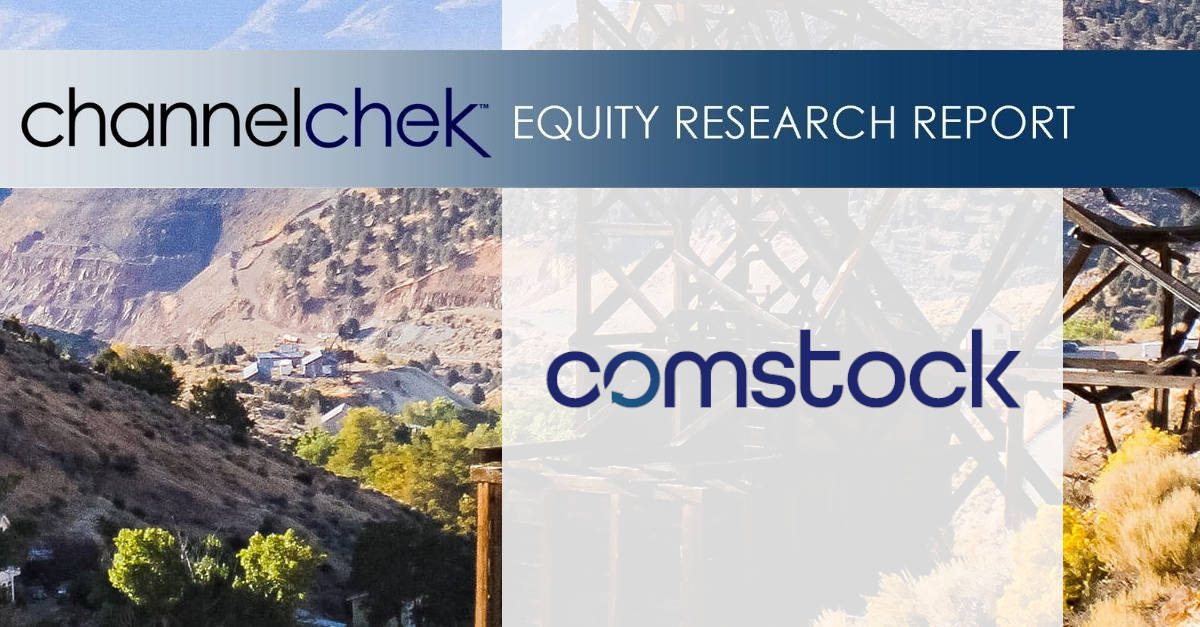Research News and Market Data on LODE
VIRGINIA CITY, Nevada, February 14, 2025 — Comstock Inc. (“Comstock”) (NYSE American: LODE), a leading innovator of renewable energy-enabling technologies that contribute to energy abundance by efficiently extracting and converting under-utilized natural resources today announced a reverse split of its common stock, $0.000666 par value (“Common Stock”), at a ratio of 1-for-10 (the “Reverse Split”), effective February 24, 2025, and that the Common Stock will begin trading on a split-adjusted basis when the market opens on February 25, 2025, resulting in approximately 23,767,578 shares outstanding.
Under Nevada law, because the Reverse Split was approved by the shareholders of the Company on February 14, 2025, and in accordance with NRS Section 78.2055, the Company may effect the Reverse Split without correspondingly decreasing the number of authorized shares. As described herein, the Company has complied with these requirements. Comstock’s authorized number of shares of Common Stock remains unchanged at 245,000,000. The Common Stock will continue to trade on the NYSE American under the trading symbol “LODE” but will trade under the new CUSIP number 205750409.
“The growth opportunities for both Fuels and Metals have developed well beyond our original expectations, and we have attracted some of the most sophisticated partners, for feedstocks, technologies, operations, governments, and refining and offtake, with many now evaluating direct investments, and in multiple cases exploring deeper and more meaningful integrations with our system” stated Corrado De Gasperis, Executive Chairman and Chief Executive Officer. “With this extraordinarily strong supporting vote, our existing shareholders have overwhelmingly supported our plans for effectively and responsibly capitalizing on our immediate opportunities and sharing in the potential for creating two unprecedented companies that turn the image of an oil well that never stops producing and a silver mine that never stops producing, into our new reality. It is just getting started.”
The reverse stock split will affect all stockholders uniformly and will not alter any stockholder’s percentage interest in the Company’s equity, except to the extent that the reverse stock split would result in a stockholder owning a fractional share. The reverse stock split will reduce the number of issued shares of the Company’s common stock from approximately 237,675,779 shares to approximately 23,767,578 shares. Proportional adjustments will be made to the number of shares of the Comstock’s common stock issuable under its equity compensation plans and upon exercise or conversion of outstanding warrants, as well as the applicable exercise prices. Stockholders whose shares are held in brokerage accounts should direct any questions concerning the reverse stock split to their broker.
The Company’s transfer agent, EQ Equiniti, will provide instructions to stockholders regarding the process for exchanging certificated shares. No fractional shares will be issued as a result of the Reverse Split as any fractional shares resulting from the Reverse Split will be rounded up to the nearest whole share. All stockholders of record may direct questions to the Company’s transfer agent, EQ Equiniti toll-free at 1-866-877-6270.
The Company will file the final tabulation of the special meeting proposal on Form 8-K on February 18, 2025.
About Comstock Inc.
Comstock Inc. (NYSE: LODE) innovates and commercializes technologies that are deployable across entire industries to contribute to energy abundance by efficiently extracting and converting under-utilized natural resources, such as waste and other forms of woody biomass into renewable fuels, and end-of-life electronics into recovered electrification metals. Comstock’s innovations group is also developing and using artificial intelligence technologies for advanced materials development and mineral discovery for sustainable mining. To learn more, please visit www.comstock.inc.
Comstock Social Media Policy
Comstock Inc. has used, and intends to continue using, its investor relations link and main website at www.comstock.inc in addition to its Twitter, LinkedIn and YouTube accounts, as means of disclosing material non-public information and for complying with its disclosure obligations under Regulation FD.
Contacts
For investor inquiries:
RB Milestone Group LLC
Tel (203) 487-2759
ir@comstockinc.com
For media inquiries or questions:
Tracy Saville
Comstock Inc.
(775) 847-7573
media@comstockinc.com
Forward-Looking Statements
This press release and any related calls or discussions may include forward-looking statements within the meaning of Section 27A of the Securities Act of 1933, as amended, and Section 21E of the Securities Exchange Act of 1934, as amended. All statements, other than statements of historical facts, are forward-looking statements. The words “believe,” “expect,” “anticipate,” “estimate,” “project,” “plan,” “should,” “intend,” “may,” “will,” “would,” “potential” and similar expressions identify forward-looking statements but are not the exclusive means of doing so. Forward-looking statements include statements about matters such as: future market conditions; future explorations or acquisitions; future changes in our research, development and exploration activities; future financial, natural, and social gains; future prices and sales of, and demand for, our products and services; land entitlements and uses; permits; production capacity and operations; operating and overhead costs; future capital expenditures and their impact on us; operational and management changes (including changes in the Board of Directors); changes in business strategies, planning and tactics; future employment and contributions of personnel, including consultants; future land and asset sales; investments, acquisitions, joint ventures, strategic alliances, business combinations, operational, tax, financial and restructuring initiatives, including the nature, timing and accounting for restructuring charges, derivative assets and liabilities and the impact thereof; contingencies; litigation, administrative or arbitration proceedings; environmental compliance and changes in the regulatory environment; offerings, limitations on sales or offering of equity or debt securities, including asset sales and associated costs; business opportunities, growth rates, future working capital, needs, revenues, variable costs, throughput rates, operating expenses, debt levels, cash flows, margins, taxes and earnings. These statements are based on assumptions and assessments made by our management in light of their experience and their perception of historical and current trends, current conditions, possible future developments and other factors they believe to be appropriate. Forward-looking statements are not guarantees, representations or warranties and are subject to risks and uncertainties, many of which are unforeseeable and beyond our control and could cause actual results, developments, and business decisions to differ materially from those contemplated by such forward-looking statements. Some of those risks and uncertainties include the risk factors set forth in our filings with the SEC and the following: adverse effects of climate changes or natural disasters; adverse effects of global or regional pandemic disease spread or other crises; global economic and capital market uncertainties; the speculative nature of gold or mineral exploration, and lithium, nickel and cobalt recycling, including risks of diminishing quantities or grades of qualified resources; operational or technical difficulties in connection with exploration, metal recycling, processing or mining activities; costs, hazards and uncertainties associated with precious and other metal based activities, including environmentally friendly and economically enhancing clean mining and processing technologies, precious metal exploration, resource development, economic feasibility assessment and cash generating mineral production; costs, hazards and uncertainties associated with metal recycling, processing or mining activities; contests over our title to properties; potential dilution to our stockholders from our stock issuances, recapitalization and balance sheet restructuring activities; potential inability to comply with applicable government regulations or law; adoption of or changes in legislation or regulations adversely affecting our businesses; permitting constraints or delays; challenges to, or potential inability to, achieve the benefits of business opportunities that may be presented to, or pursued by, us, including those involving battery technology and efficacy, quantum computing and generative artificial intelligence supported advanced materials development, development of cellulosic technology in bio-fuels and related material production; commercialization of cellulosic technology in bio-fuels and generative artificial intelligence development services; ability to successfully identify, finance, complete and integrate acquisitions, joint ventures, strategic alliances, business combinations, asset sales, and investments that we may be party to in the future; changes in the United States or other monetary or fiscal policies or regulations; interruptions in our production capabilities due to capital constraints; equipment failures; fluctuation of prices for gold or certain other commodities (such as silver, zinc, lithium, nickel, cobalt, cyanide, water, diesel, gasoline and alternative fuels and electricity); changes in generally accepted accounting principles; adverse effects of war, mass shooting, terrorism and geopolitical events; potential inability to implement our business strategies; potential inability to grow revenues; potential inability to attract and retain key personnel; interruptions in delivery of critical supplies, equipment and raw materials due to credit or other limitations imposed by vendors; assertion of claims, lawsuits and proceedings against us; potential inability to satisfy debt and lease obligations; potential inability to maintain an effective system of internal controls over financial reporting; potential inability or failure to timely file periodic reports with the Securities and Exchange Commission; potential inability to list our securities on any securities exchange or market or maintain the listing of our securities; and work stoppages or other labor difficulties. Occurrence of such events or circumstances could have a material adverse effect on our business, financial condition, results of operations or cash flows, or the market price of our securities. All subsequent written and oral forward-looking statements by or attributable to us or persons acting on our behalf are expressly qualified in their entirety by these factors. Except as may be required by securities or other law, we undertake no obligation to publicly update or revise any forward-looking statements, whether as a result of new information, future events, or otherwise. Neither this press release nor any related calls or discussions constitutes an offer to sell, the solicitation of an offer to buy or a recommendation with respect to any securities of the Company, the fund, or any other issuer.














